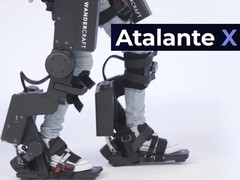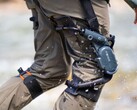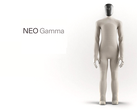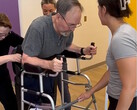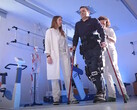Wandercraft has presented data from its latest study showing gait improvement after a month of use of the Atalante X exoskeleton in a 64-year-old female with left-side paralysis acquired following a stroke seven years ago.
Stroke causes 1 in 6 deaths in the US according to the CDC, and those who do not die are often left with lasting physical impairments such as paralysis. Rehabilitation must typically begin within the first six months following a stroke in order to see significant recovery, with little to no effect after a year. Traditional rehabilitation is difficult for the patient because of the high chance of falls due to the lack of muscle control for balance, and therapists struggle to maintain patients upright during therapy.
The Nvidia-powered Wandercraft exoskeleton is a self-balancing powered suit that patients can wear to move about in without worry. This greatly eliminates the chance of falls, and the focus during rehabilitation can be placed on improving muscle control and gait rather than trying to stay upright.
For the 64-year-old woman, stride length and speed of steps increased while the asymmetry in movements between the right (non-paralyzed) and left side (paralyzed) of her body decreased. Importantly, this gain in mobility occurred seven years post-stroke and well after physical therapists would normally have expected to see improvement during rehabilitation.
Readers in the United States who are interested in participating in Wandercraft's latest interventional clinical trial of the exoskeleton for individuals with spinal cord injury (SCI) can contact clinicaltrials@wandercraft.health. Even without physical improvement, people with disabilities wearing the Wandercraft exoskeleton can still walk the city like Kevin Piette did while carrying the Olympics 2024 torch.
Source(s)
Wandercraft’s Atalante X Enables Significant Gait Improvements in Post-Stroke Gait Rehabilitation in New Case Study
Results Using Groundbreaking Robotic Exoskeleton with Dynamic Ankle Function Presented at the Annual American Physical Therapy Association Combined Sections Meeting
New York, NY (February 13, 2025) – An innovative case study on robotic exoskeleton technology and post-stroke gait rehabilitation will be presented at the annual American Physical Therapy Association Combined Sections Meeting in Houston, TX. The study*, "Improvements in Gait After Utilization of a Robotic Exoskeleton with Dynamic Ankle Function Post Stroke," highlights the use of Wandercraft’s Atalante X. This robotic exoskeleton with a powered dynamic ankle improved functional ambulation and loading mechanics in a chronic stroke survivor.
The study evaluated a 64-year-old patient with left-sided hemiplegia. The participant completed a four-week robotic-assisted walking program using Atalante X, a groundbreaking self-balancing exoskeleton developed by Wandercraft. It features a powered dynamic ankle that allows for replication of physiologic gait mechanics.
The results showed:
- Gait speed more than doubled, increasing from 0.09 m/s to 0.19 m/s (measured via the 10-meter walk test)
- Cadence improved by 27.8%, rising from 32.7 steps/minute to 41.8 steps/minute
- Loading mechanics showed increased symmetry and propulsion
- Temporal spatial parameters, including paretic stride length and improved limb symmetry, showed marked improvement
- No adverse events occurred
“These findings reinforce the potential of robotic exoskeletons in chronic stroke rehabilitation,” said Dr. Christina Dandola, Research Physical Therapist at Kessler Foundation. “By incorporating a powered dynamic ankle, we’re able to promote more natural movement mechanics while addressing spasticity and range of motion limitations at the ankle, which could have long-term benefits for stroke survivors.”
The study offers promising evidence for the safety and effectiveness of exoskeleton-assisted rehabilitation in chronic stroke cases. However, the authors emphasized the need for more research to confirm these findings and refine clinical applications.
Contact sophie.pellas@wandercraft.health if you would like to schedule a demonstration of the Atalante X.
*Authors: Christina M. Dandola, PT, DPT1, Joshua Breighner, PT, DPT2, Gregory R. Ames, MS1, Katie M. Broderick, PT, DPT1,3, Karen J. Nolan, PhD1,4
1Center for Mobility and Rehabilitation Engineering, Kessler Foundation, West Orange, NJ
2Wandercraft SAS, Paris, France
3Kessler Institute for Rehabilitation, West Orange, NJ
4Department of PM&R, Rutgers - New Jersey Medical School, Newark, NJ
About Wandercraft
Wandercraft is on a mission to give everyone the opportunity to stand up and walk again. Known for the first-of-its-kind Personal Exoskeleton, Wandercraft is building the next generation of solutions to restore walking ability at home and in rehabilitation, including the Atalante X—a revolutionary tool in use within inpatient and outpatient rehab centers worldwide. By blending advanced robotics with a deeply human purpose, Wandercraft aims to provide new options for movement and soon transform the way wheelchair users experience walking mobility in their everyday lives. Committed to innovation and accessibility, Wandercraft welcomes collaboration with rehabilitation centers, healthcare professionals, and the broader community of wheelchair users to expand opportunities in modern mobility.
For more information, visit www.wandercraft.eu.
Media Contact
Lilly Kofler
Global Head of Marketing & Communications
lilly.kofler@wandercraft.health




